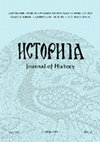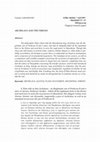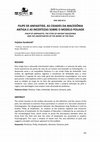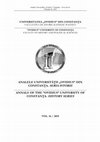Papers by Vojislav Sarakinski

Živa Antika / Antiquité Vivante, Dec 2024
The philosopher Plato claims that the Macedonian king Archelaus was the illegitimate son of Perdi... more The philosopher Plato claims that the Macedonian king Archelaus was the illegitimate son of Perdiccas II and a slave, and that he allegedly killed all the legitimate heirs to the throne and seized royal power in Macedonia by force. Although this story was well known in ancient times, modern scholars question it, either in whole or in part; nevertheless, all attempts to prove that it is unfounded are based on assumptions and inferences from circumstantial arguments. The reassessment of our sources, as well as a comparison with appropriate examples concerning the succession of royal power in Macedon, shows that even if the details of Polus’ speech are extremely doubtful, its essence – the killing of Alcetas, Alexander and little Aero-pus – may be accepted as a historical fact. At the same time, the context of the killings is probably not an invention of Plato, but comes from the propaganda mythoi that were a feature of the dynastic struggles between the Argeadae. What remains unclear is whether this propaganda dates from the time when Archelaus was still fighting for the throne, or whether it emerged later, in the troubled decade after his death and the murder of his son, which ended his lineage.

Živa Antika / Antiquité Vivante , 2023
The earliest sources on the kingdom of Macedon refer to its royal house as the Temenidae. Through... more The earliest sources on the kingdom of Macedon refer to its royal house as the Temenidae. Through this name, the Macedonian kings allegedly claimed descent from the royal line of Argos, i.e., they claimed the right to be recognized as descendants of Temenus, and through him of Heracles himself. Other ancient authors, as well as later lexicographers, refer to the Macedonian royal house as the Argeadae. There were two different explanations for this name even in ancient times: some interpreted it as an indication of the origin of the royal house from Argos Orestikon, a place in Orestis; others thought it was a patronymic, i.e. that it pointed to a descent from a mythical ancestor, the hero Argaeus. A careful analysis of the sources, as well as the historical circumstances in which they mention the ruling house and its name, shows that these names and the corresponding myths were used erratically, with irregular frequency, within a specific narrative with a political goal, to the point that one might even dispute the Macedonian origin of some interpretations. Thus, it is possible that the Macedonian kings before Philip II did not perceive themselves as either Temenid or Argead, and that Philip and Alexander only made masterful political use of the said names and interpretations. The new Hellenistic dynasties did their best to link with the old one in various ways: the Antigonidae highlighted their kinship with Argos, the Ptolemies opted for Argaeus, the Seleucids for Temenus. An examination of these examples shows that the term “Argeadae” had no exactness in historical reminiscence. In Hellenistic times – and that is precisely the time when it appears in common use – “Argeadae” was a general term that referred to the kings of Macedonia. Thus, it would be unwarranted to replace the term Temenidae with another, equally gratuitous, which ultimately lays claim to the same legendary origin, and was first attested a considerable time later; on the contrary, the Temenidae should remain an integral part of the narrative on the Macedonian ruling house.
Пајонија и Пајонците. Извори, историја, археологија, 2022

Историја / Journal of History, 2021
This article aims to explore the extant sources documenting the emergence of organised football i... more This article aims to explore the extant sources documenting the emergence of organised football in Ottoman Macedonia – mainly newspaper articles and notes by local chroniclers. In Ottoman Macedonia, football was mainly played in Salonica by the sons of the Jewish, Greek, and Western bourgeoisie, and in Bitola by the sons of rich Aromanians; after the Young Turk Revolution, it was played by western-educated Turkish officers in Skopje and Bitola, and by some citizens of Naoussa, Veria and Edessa in southwest Macedonia. The sport may have made a late start, but it walked the same route as football in Great Britain and Western Europe did. It started as a sport for the city élite, who quickly got fed up with the novelty and turned to seeking new thrills in other sports; had it not been for the Balkan Wars and WWI, football would have probably become a real working- class sport as early as the 1910s – as it did during the Interwar period in the former territories of Ottoman Macedonia that became part of Greece, Bulgaria and the Kingdom of Serbs, Croats and Slovenes.
Историја / Journal of History , 2021
Во статијата е даден целосен македонски превод на зачуваниот текст на атинските декрети за Метона... more Во статијата е даден целосен македонски превод на зачуваниот текст на атинските декрети за Метона, проследен со белешки, објаснувања и куса дискусија за датирањето и историскиот контекст на документите. Даден е преглед на досегашната литература и на спротивставените мислења во врска со датирањето, кои се движат од 430 до 426 ст.е; од анализата на досега понудените аргументи, произлегува дека пристапувањето на Метона во Атинскиот поморски сојуз треба да се датира меѓу мај 432 и август 431 ст.е., а првиот атински декрет за Метона – во рана пролет 428 ст.е., како што предлага Н. Хамонд.

Жива Антика / Antiquité Vivante , 2020
Данная статья не исследует были ли античные македонцы эллинами или нет, хотя оспаривается сама к... more Данная статья не исследует были ли античные македонцы эллинами или нет, хотя оспаривается сама концепция дихотомии. Она очень редко имела значение в античное время, но имеет большее значение как инструмент современных историков. Суть дискуссии дистанцируется от традиционных дилемм – что мы знаем о ма-кедонцах, были ли они эллинами, имели ли они региональную идентичность – и, с помощью избранных примеров и параллелей остановимся на фактах што, если выберем практичное определение Геродота, используется всеми, мы по сути дела не знаем когда, на каком основании и для кого кто-то является варваром, а кто-то нет. Уже блеклые критерии принадлежности к эллинизму или варварству должны быть отвергнуты, потому что сами эти термины представляют собой подвижную и неравномерную конструкцию; история античной Македонии должна освободиться от напряжения этого вопроса, который долго обрабатывается по несоответствующей методологии.
Христофор Жефарович и неговото време, 2020

Annuaire de la Faculté de Philosophie, 2020
The philosopher Plato claims that the Macedonian king Archelaus was the illegitimate son of Perdi... more The philosopher Plato claims that the Macedonian king Archelaus was the illegitimate son of Perdiccas II and a slave, and that he allegedly killed all the legitimate heirs to the throne and used force to seize the royal power in Macedonia. Though this story was well known in ancient times, modern scholars dispute it, either fully or partially; nevertheless, all attempts to prove that it is unfounded are based on assumptions and a conjecture of circumstantial arguments. The reanalysis of our sources, as well as a comparison with suitable examples concerning the succession of royal power in Macedon point out that succession issues in Aegae were not, however, completely clear-cut; that the silence of Thucydides concerning the transfer of power, until he had introduced Archelaus as king, though not decisive, may nevertheless be indicative; that the position of Archelaus in terms of succession was complicated, regardless of whether he was a legitimate son; and finally, that, if nothing else, the story of Plato deserves much greater scrutiny and should by no means be disregarded due to academic inertia, as is usually the case.

Pólis, Urbs e Cidades no Mediterrâneo Antigo, 2019
Este artigo toca a discussão interminável sobre a definição e a natureza da pólis, mas tenta exam... more Este artigo toca a discussão interminável sobre a definição e a natureza da pólis, mas tenta examiná-las do ponto de vista de um evento real atestado na historiografia-o desacordo entre o rei macedônio Pérdicas II e seu irmão Filipe de Anfaxitide. Uma análise do significado político, logístico e econômico de Anfaxitide para o reino macedônico é seguida de uma visão geral das descobertas arqueológicas; isso serve para provar a discrepância entre o que conhecemos na área e a maneira como ou pela qual as cidades ao longo do rio Áxio são apresentados nas obras da historiografia moderna. Isso coloca uma sombra de dúvida sobre a própria definição da pólis e sugere uma abordagem mais ampla e mais afrouxada do problema. / The article touches on the endless discussion on the definition and the nature of the polis, but attempts to examine these parameters in context of a real event attested in historiography: the disagreement between the Macedonian king Perdiccas II and his brother Philip of Amphaxitis. An analysis of the political, logistical and economic significance of Amphaxitis for the kingdom of Macedon is followed by an overview of the archaeological finds, which serves to prove the discrepancy between what we know from the field and how the cities of Amphaxitis are presented in modern historiography. This casts a shadow of doubt over the very definition of polis and suggests a broader and looser approach to the problem.
Гласник ИНИ, 2019
The aim of this paper is to review once more the evidence for the alleged co-regency of Gonatas a... more The aim of this paper is to review once more the evidence for the alleged co-regency of Gonatas and Demetrios II, as well as the interpretations offered by modern historians. While it is accepted that, considering all the evidence, the theories of both R. M. Errington and E. Grzybek are untenable, it is maintained that contrary to the opinion of a number of historians, the question is still far from settled. The contradictions in the sources remain unresolved, and most of the offered explanations are unconvincing or at the very least hypothetical, which is why the firm stance on the issue taken by some researchers (whether for or against a co-regency) seems unfounded. Considering the scarcity and the contradicting nature of the available evidence, a definitive solution of the issue remains impossible until a new piece of information presents itself.

Analele Universităţii Ovidius din Constanţa, 2019
Less than a century after the death of Hristofor Žefarović (1690– 1753), a renowned artist, autho... more Less than a century after the death of Hristofor Žefarović (1690– 1753), a renowned artist, author, merchant, heraldist and supporter of the “Illyrian idea”, Balkan historiographies began trying to determine his ethnicity – or, rather, his nationality – under the influence of national ideologies for which they sought legitimacy. However, the question of the attested identity markers of Hristofor Žefarović presents a complex methodological problem that cannot (and should not) be treated unilaterally, on the basis of fragmentary and selective pieces of information brought out of context. A thorough analysis of the extant sources, containing an extensive set of contextual identity markers, shows that – at this time, and until a better and more explicit source comes to light – modern historiography is objectively unable to determine the ethnicity of Hristofor Žefarović in modern terms. Furthermore, it is questionable whether this kind of conclusion can be reached at all, as our sources testify to a remarkable fluidity in ethnical markers and norms of self-determination in the times of Žefarović, which would be nearly outrageous under the terms of modern-day politics. Consequently, from a methodological viewpoint, the case of the ethnicity and self-identification of Hristofor Žefarović cannot be defined in any other way, except as putting the past in function of building contemporary national ideologies.

Exegi monumentum aere perennius. Papers in Honor of prof. E. Koleva, prof. Lj. Basotova and prof. D. Čadikovska on the Occasion of the 85th Anniversary of Their Birth, 2019
The aim of the paper is to re‐evaluate the role and importance of Alexander I during the Persian ... more The aim of the paper is to re‐evaluate the role and importance of Alexander I during the Persian invasion of Greece, particularly pertaining the embassy to Athens and the night visit before the battle of Plataea. It is maintained that his role and importance in the back‐door dealings between the Athenians and Spartans while he was at Athens is probably exaggerated; while at the same time, in overstepping his role as an envoy of Mardonius, he had in fact harmed his reputation as benefactor and friend of Athens. Concerning the visit before Plataea, there is admittedly a certain pro‐Macedonian nuance in the narrative; yet, this does not mean that it should be treated as a standalone affair, separated from the rest of the narrative, but rather in context of a much larger piece of propaganda which aims to glorify the deeds of Athens at the expense of the Spartan ones – certainly not as an example of an interpretatio Macedonica.

Živa Antika / Antiquité Vivante, 2018
Nous réexaminons les mentions d’étrangers dans les sources écrites mycéniennes, ainsi que la coll... more Nous réexaminons les mentions d’étrangers dans les sources écrites mycéniennes, ainsi que la collection de noms de personnes et de démonymes, afin de déterminer si ces personnes sont des réfugiés ou des migrants, ainsi que le type de migrants auquel elles appartiennent. Cependant, la position d’un migrant ou d’un réfugié implique une «altérité» claire et visible de la société dans laquelle il immigre, ainsi que des problèmes d’intégration et un faible niveau de participation à la société; les « étrangers » mentionnés dans les textes mycéniens ne semblent pas présenter ces traits. Nous constatons que, même si la majorité d’exemples attestés sont clairs, incontestés et posent peu de problèmes, la base méthodologique de la question elle-même est prob-lématique, car elle semble reposer sur des notions de société modernes, qui ne devraient être appliquées aux sociétés prémodernes que avec une prudence extrême.

Aula: Потрага по богатството на јазикот, мислата и културата. Зборник во чест на Маргарита Бузалковска Алексова по повод пензионирањето., Oct 28, 2018
Especially in Hellenistic times, the Macedonian phalanx was thought to be a cumbersome and vulner... more Especially in Hellenistic times, the Macedonian phalanx was thought to be a cumbersome and vulnerable formation, whose eventual success was far too dependent of the terrain, so that it could be an equal opponent of the fluid and flexible Roman legions.
This impression of the inferiority of the phalanx as opposed to the legion is based not only on the outcome of the battle of Pydna, but also on a comprehensive breakdown offered by Polybius, who observes the peculiarities and differences between the legion and the phalanx in the context of the battle at Cynoscephalae. At first glance, his conclusions appear logical and entirely justified; Polybius skillfully exposes and explains the weaknesses of the phalanx, the advantages of the Roman legion and the reasons for the constant defeats of the Hellenistic armies. However, a more thorough scrutiny of the events at Aoi Stena and Atrax, along with certain sequences from the battles of Selasia, Cynoscephalae and Pydna, shows that the interpretation offered by Polybius is neither entirely convincing, nor entirely appropriate. It is an indisputable fact that the Roman army was stronger than the armies of the Hellenistic kingdoms: the wars of the 2nd century BC prove this quite clearly and indisputably. The main question, however, is something entirely different: is the inadequacy of the phalanx indeed the main reason for the persistent defeats of the Hellenistic armies, especially when our sources clearly show that, contrary to whatever Polybius tends to prove, it was neither cumbersome, nor helpless?
The problem is that both Polybius and countless other historians influenced by his views identify the Macedonian phalanx – which was only a part, though undeniably the most important part of the Macedonian army – with the entire army; however, in the episodes intented to serve as proof, the legions do not defeat the phalanx, but the army. One should not explain the persistent defeats of the Hellenistic armies with the inadequacies of the phalanx as a formation, but rather with the inadequate composition of the armies and, above all, with the inadequate tactical principles of their military leaders. Taken as a whole, the Macedonian army proved to be incapable of adapting to the Roman system of maniples; but Polybius and others overlook that the phalanx and the army are not synonymous. In order to explain the constant inferiority of the Hellenistic armies to the Roman legions, we ought to look at the other constituent units and formations.

Živa Antika / Antiquite Vivante, Dec 30, 2017
Après un épreuve des sources existantes, ainsi que des problèmes de toponymie et de topographie, ... more Après un épreuve des sources existantes, ainsi que des problèmes de toponymie et de topographie, les auteurs soutiennent que le lac Kerkinitis – comme des autres chercheurs l’ont précédemment proposé – devrait être identifié avec le lac marécageux septentrional sur le cours inférieur du Strymon, et que le lac meridional devrait alors être le lac Prasias. Cette solution affecte notre compréhension des lieux et des événements de plusieurs façons. (1) Nous évitons la situation contradictoire d’un mont Kerkinè (prétendument Mt. Ograjden) loin au nord et d’un lac Kerkinitis adéquat près de l’embouchure du Strymon. Le lac Kerkinitis – le lac strymonique septentional – serait ainsi situé juste en dessous des pentes meridionales du mont Kerkinè, la Belasitsa d’aujourd’hui. (2) Le récit d’Hérodote sur l’avance de l’armée perse le long de la côte devient géographiquement valide. (3) Nous évitons la caractérisation bizarre du Mont Orbélos comme une frontière que, induits en erreur par l’interprétation de nos sources, nous tendons à chercher vers le nord. Les habitants du lac inférieur étant les Siropaiones, Orbélos marquerait la frontière à la soi-disant Péonie du Strymon, décrite par Hérodote. (4) Le mont Orbélos doit être situé à proximité immédiate du lac inférieur. L’Orvilos/Orbélos (Alibotouch/Kitka/Slavjanka) d’aujourd’hui se trouve trop loin au nord; les habitants locaux auraient eu accès facile au bois de construction d’un endroit plus proche. Au sud se trouve le Pangée (Couchinitsa), une montagne dont le nom est établi avec certitude; ainsi, le mont Orbélos devrait être presque certainement identifié avec le Meníkio (Serski Bozdag/Zmijnica).

ΚΡΑΤΙΣΤΟΣ, Volume in Honour of Professor Peter Delev, Sep 1, 2017
Сред многобройните проблеми около Егейската кампания на Филип V през 201 г. пр. Хр. битката при Х... more Сред многобройните проблеми около Егейската кампания на Филип V през 201 г. пр. Хр. битката при Хиос е от съществено значение. Мястото ѝ в последователността на събитията, обстоятелствата, които водят до нея, както и последствията, отдавна предизвикват спорове сред учените. Повечето изследователи изказват предположения, че в запазения у Полибий списък на загубите има грешки. Все пак почти единодушно се приема, че битката представлява съкрушителна победа на обединената флота на Родос и Пергам.
Основната цел на настоящето изследване е евентуално ревизиране на списъка на загубите. Ние смятаме, че има достатъчно данни, колкото и да са обстоятелствени, че представената картина от Полибий има нужда да бъде модифицирана. Като оставим настрана пропагандата на воюващите страни и причините за техните противоречащи си претенции, ние се фокусираме върху няколко причини, поради които списъкът на загубите изглежда съмнителен. Някои от тях произтичат от изворите, използвани от Полибий. Други, според нас, са резултат от погрешно тълкуване на съвременните историци. Тъй като отдавна е установено, че загубите на съюзниците са занижени, надеждността на македонските загуби също би трябвало да се оспори. Това заключение се основава отчасти върху хода на самата битка; чрез защитната си позиция Филип успява да осуети пълното разгръщане на превъзхождащия го родоски флот, чиито командващи, от друга страна, предпочитат да се въздържат доколкото е възможно от близка битка с македонските моряци. Освен това най-големите полиреми, дори и повредени, не са потъвали веднага и често можело да бъдат спасени чрез навременни мерки от приятелските кораби. Често е обръщано внимание, че не съюзниците, а Филип е този, който плава сред останките от корабокруширалите кораби на следващия ден. Ние предпочитаме да разглеждаме това като спасителна операция.
Специално внимание е отделено на глагола (δια)φθείρω, обикновено разбиран като „унищожавам“, „потопявам“ и др. В контекста на морското дело обаче, би трябвало да се предпочете значението „правя неспособен“ или „повреждам“. В редица случаи не може да сме сигурни дали става въпрос за унищожен или просто изваден извън сторя кораб, поради което трябва да сме предпазливи при превода и интерпретацията на този израз и съответно – при преценката на македонските загуби. При всички положения заключението е въпрос на нюанси: Филип със сигурно е загубил повече кораби и хора отколкото съюзниците, но загубите му са били доста под предполагаемите според описанието на Полибий. Фактът че Филип успява да продължи с офанзивата си и в крайна сметка да акостира в Кария, показва, че поне за него битката при Хиос не е смятана за определяща – впечатление, което се подсилва и от нежеланието на съюзниците да настояват за решителна развръзка на следващия ден.
До същото заключение се достига и при разбора на тактическата ситуация след битката. Въпреки че плановете на Филип биват провалени, той все още е достатъчно силен, за да продължи операцията, а когато сезонът приключва с донякъде неудобната блокада в Баргилия, това не би трябвало да се отдава изключително на претърпените загуби в битката при Хиос. В заключение, въпреки ожесточеността на сражението и понесените загуби от двете страни, макар да няма никакво съмнение, че Филип е губещата страна, резултатът от битката остава неубедителен.

70 години Институт за историја – 70 години македонска историографија [70 Years of the Institute of History – 70 Years of Macedonian Historiography], 2017
This paper puts to test the virtually axiomatic historical paradigm of the inevitability of the c... more This paper puts to test the virtually axiomatic historical paradigm of the inevitability of the clash between Sparta and Athens as carriers of two opposing political and cultural concepts, and hence the inevitability of the Peloponnesian War itself. This ultimately leads us to the question of the real goal of the Athenian ventures in the late 430s, namely, whether the Athenian policy as a whole was directed against Corinth and Sparta, or if there was another venture that the Athenians had in mind, a venture which unfortunately ignited the fire of the Peloponnesian War. We offer a detailed look at several issues: (1) whether the Athenians are conducting preparations for war at that time, (2) which war they actually have in mind, (3) whether Thucydides reveals their immediate plans, (4) if he does, indeed, whether they are aimed at Corinth and Sparta, and (5) if he does not, what are the reasons for it.
Several important details suggest that the Athenian foreign policy was far from showing the uniformity we expect to find; that the Athenian policies rather consisted of a mosaic of small, opportune political decisions with hardly any ideological deposit; and that the hostilities in the North, which presented the main grievance leading to the Peloponnesian War, were not necessarily aimed at Corinth and certainly not at Sparta. One could argue that the Poteidaian affair was meant to be a part of a projected short, limited and controlled “Macedonian War”, supposed to begin and to end in a single battle season, a war which would once and for all secure both the primary and the alternative sources of Athenian timber supply. However, not least because of the paradigm of a Peloponnesian War that emerges from the realm of ananke – a paradigm seemingly modern, but actually rooted in classical historiography – the “Macedonian war” will certainly continue to be absent from historical literature. And this, it would seem, is a perfect reminder that historical paradigms need to be constantly checked and redefined.

Philip of Amphaxitis, the brother of Perdiccas II, is usually said to be a pretender to the Maced... more Philip of Amphaxitis, the brother of Perdiccas II, is usually said to be a pretender to the Macedonian throne. This alleged pretender, however, made absolutely no move against his brother until 432 BC, when Athens finally entered the fray. What is more, Philip neither struck coin, nor made an attempt to establish a legislative body or a state council of any sort. This, in addition to several other peculiarities of his arkhe in Amphaxitis, hints that he neither claimed the throne of the kingdom of the Argeadae, nor could he count on any level of support by the legislative bodies in Aegae. A thorough analysis of the events suggests that he simply chose to act independently and stop responding to the capital. Philip moved for the throne only after losing Amphaxitis and after securing the help and support of Derdas of Elymea and Athens: before that, he had neither power, nor a strong enough motive to fight for the royal regalia. After more than twenty years of independent rule in Amphaxitis, Philip was made a victim of Athenian political interests. In 432 BC, Athens succumbed to the needs of their Realpolitik, switched sides and gave nominal support to Perdiccas II.

Simultaneously with the siege of Thasos, ten thousand Athenian and allied colonists went on their... more Simultaneously with the siege of Thasos, ten thousand Athenian and allied colonists went on their way to establish a settlement at Ennea Hodoi, a crossing controlled by the Edonians. This attempt came to a grievous end, as – their alleged hostility notwithstanding – the Edonians and Alexander the Philhellene most probably had common interests in the area.
It would be very reasonable, in 479 BC, to keep an active military force and try to implement some sort of administrative overview over Edonia; fifteen years later, however, after all immediate external threats became a thing of the past, Alexander withdrew the formal border of the kingdom to the west in order to alleviate the cost of keeping soldiers and administrators that far from the capital at Aegae.
This, however, did not mean that Edonia left the Macedonian sphere of interest and/or influence. Ruled by a local basileus, they obviously remained ξύμμαχοι καὶ ὑπήκοοι (“allies and subjects”), following the pattern of certain tribes in western Upper Macedonia. Accordingly, in fighting the colonists sent by Athens, they seem to have acted in cooperation with the Argeadai – a fact that took the Athenians by surprise.
There are numerous documents that provide various information about
the Greek aspirations toward ... more There are numerous documents that provide various information about
the Greek aspirations toward the region of Macedonia. A question that keeps reappearing is when those aspirations began and how large a territory they encompassed. Early statements of representatives of the Greek political and intellectual elite show that during the time the Greek state was in its infancy, Macedonia was not a political priority. Greek opinions on Ancient Macedonia and Macedonian kings replicate this impeccably. We follow the presentation of ancient Macedonians from ‘barbarians’ and ‘enslavers’ in the 1830s, to ‘Hellenes’ and ‘saviors of Hellenism’ in the 1850s, showing that ancient Macedonians, proclaimed to be Greeks by the means of a textbook, became a focal point of Greek historiography for reasons that were closer to Realpolitik than to scholarly and scientific truth.











Uploads
Papers by Vojislav Sarakinski
This impression of the inferiority of the phalanx as opposed to the legion is based not only on the outcome of the battle of Pydna, but also on a comprehensive breakdown offered by Polybius, who observes the peculiarities and differences between the legion and the phalanx in the context of the battle at Cynoscephalae. At first glance, his conclusions appear logical and entirely justified; Polybius skillfully exposes and explains the weaknesses of the phalanx, the advantages of the Roman legion and the reasons for the constant defeats of the Hellenistic armies. However, a more thorough scrutiny of the events at Aoi Stena and Atrax, along with certain sequences from the battles of Selasia, Cynoscephalae and Pydna, shows that the interpretation offered by Polybius is neither entirely convincing, nor entirely appropriate. It is an indisputable fact that the Roman army was stronger than the armies of the Hellenistic kingdoms: the wars of the 2nd century BC prove this quite clearly and indisputably. The main question, however, is something entirely different: is the inadequacy of the phalanx indeed the main reason for the persistent defeats of the Hellenistic armies, especially when our sources clearly show that, contrary to whatever Polybius tends to prove, it was neither cumbersome, nor helpless?
The problem is that both Polybius and countless other historians influenced by his views identify the Macedonian phalanx – which was only a part, though undeniably the most important part of the Macedonian army – with the entire army; however, in the episodes intented to serve as proof, the legions do not defeat the phalanx, but the army. One should not explain the persistent defeats of the Hellenistic armies with the inadequacies of the phalanx as a formation, but rather with the inadequate composition of the armies and, above all, with the inadequate tactical principles of their military leaders. Taken as a whole, the Macedonian army proved to be incapable of adapting to the Roman system of maniples; but Polybius and others overlook that the phalanx and the army are not synonymous. In order to explain the constant inferiority of the Hellenistic armies to the Roman legions, we ought to look at the other constituent units and formations.
Основната цел на настоящето изследване е евентуално ревизиране на списъка на загубите. Ние смятаме, че има достатъчно данни, колкото и да са обстоятелствени, че представената картина от Полибий има нужда да бъде модифицирана. Като оставим настрана пропагандата на воюващите страни и причините за техните противоречащи си претенции, ние се фокусираме върху няколко причини, поради които списъкът на загубите изглежда съмнителен. Някои от тях произтичат от изворите, използвани от Полибий. Други, според нас, са резултат от погрешно тълкуване на съвременните историци. Тъй като отдавна е установено, че загубите на съюзниците са занижени, надеждността на македонските загуби също би трябвало да се оспори. Това заключение се основава отчасти върху хода на самата битка; чрез защитната си позиция Филип успява да осуети пълното разгръщане на превъзхождащия го родоски флот, чиито командващи, от друга страна, предпочитат да се въздържат доколкото е възможно от близка битка с македонските моряци. Освен това най-големите полиреми, дори и повредени, не са потъвали веднага и често можело да бъдат спасени чрез навременни мерки от приятелските кораби. Често е обръщано внимание, че не съюзниците, а Филип е този, който плава сред останките от корабокруширалите кораби на следващия ден. Ние предпочитаме да разглеждаме това като спасителна операция.
Специално внимание е отделено на глагола (δια)φθείρω, обикновено разбиран като „унищожавам“, „потопявам“ и др. В контекста на морското дело обаче, би трябвало да се предпочете значението „правя неспособен“ или „повреждам“. В редица случаи не може да сме сигурни дали става въпрос за унищожен или просто изваден извън сторя кораб, поради което трябва да сме предпазливи при превода и интерпретацията на този израз и съответно – при преценката на македонските загуби. При всички положения заключението е въпрос на нюанси: Филип със сигурно е загубил повече кораби и хора отколкото съюзниците, но загубите му са били доста под предполагаемите според описанието на Полибий. Фактът че Филип успява да продължи с офанзивата си и в крайна сметка да акостира в Кария, показва, че поне за него битката при Хиос не е смятана за определяща – впечатление, което се подсилва и от нежеланието на съюзниците да настояват за решителна развръзка на следващия ден.
До същото заключение се достига и при разбора на тактическата ситуация след битката. Въпреки че плановете на Филип биват провалени, той все още е достатъчно силен, за да продължи операцията, а когато сезонът приключва с донякъде неудобната блокада в Баргилия, това не би трябвало да се отдава изключително на претърпените загуби в битката при Хиос. В заключение, въпреки ожесточеността на сражението и понесените загуби от двете страни, макар да няма никакво съмнение, че Филип е губещата страна, резултатът от битката остава неубедителен.
Several important details suggest that the Athenian foreign policy was far from showing the uniformity we expect to find; that the Athenian policies rather consisted of a mosaic of small, opportune political decisions with hardly any ideological deposit; and that the hostilities in the North, which presented the main grievance leading to the Peloponnesian War, were not necessarily aimed at Corinth and certainly not at Sparta. One could argue that the Poteidaian affair was meant to be a part of a projected short, limited and controlled “Macedonian War”, supposed to begin and to end in a single battle season, a war which would once and for all secure both the primary and the alternative sources of Athenian timber supply. However, not least because of the paradigm of a Peloponnesian War that emerges from the realm of ananke – a paradigm seemingly modern, but actually rooted in classical historiography – the “Macedonian war” will certainly continue to be absent from historical literature. And this, it would seem, is a perfect reminder that historical paradigms need to be constantly checked and redefined.
It would be very reasonable, in 479 BC, to keep an active military force and try to implement some sort of administrative overview over Edonia; fifteen years later, however, after all immediate external threats became a thing of the past, Alexander withdrew the formal border of the kingdom to the west in order to alleviate the cost of keeping soldiers and administrators that far from the capital at Aegae.
This, however, did not mean that Edonia left the Macedonian sphere of interest and/or influence. Ruled by a local basileus, they obviously remained ξύμμαχοι καὶ ὑπήκοοι (“allies and subjects”), following the pattern of certain tribes in western Upper Macedonia. Accordingly, in fighting the colonists sent by Athens, they seem to have acted in cooperation with the Argeadai – a fact that took the Athenians by surprise.
the Greek aspirations toward the region of Macedonia. A question that keeps reappearing is when those aspirations began and how large a territory they encompassed. Early statements of representatives of the Greek political and intellectual elite show that during the time the Greek state was in its infancy, Macedonia was not a political priority. Greek opinions on Ancient Macedonia and Macedonian kings replicate this impeccably. We follow the presentation of ancient Macedonians from ‘barbarians’ and ‘enslavers’ in the 1830s, to ‘Hellenes’ and ‘saviors of Hellenism’ in the 1850s, showing that ancient Macedonians, proclaimed to be Greeks by the means of a textbook, became a focal point of Greek historiography for reasons that were closer to Realpolitik than to scholarly and scientific truth.
This impression of the inferiority of the phalanx as opposed to the legion is based not only on the outcome of the battle of Pydna, but also on a comprehensive breakdown offered by Polybius, who observes the peculiarities and differences between the legion and the phalanx in the context of the battle at Cynoscephalae. At first glance, his conclusions appear logical and entirely justified; Polybius skillfully exposes and explains the weaknesses of the phalanx, the advantages of the Roman legion and the reasons for the constant defeats of the Hellenistic armies. However, a more thorough scrutiny of the events at Aoi Stena and Atrax, along with certain sequences from the battles of Selasia, Cynoscephalae and Pydna, shows that the interpretation offered by Polybius is neither entirely convincing, nor entirely appropriate. It is an indisputable fact that the Roman army was stronger than the armies of the Hellenistic kingdoms: the wars of the 2nd century BC prove this quite clearly and indisputably. The main question, however, is something entirely different: is the inadequacy of the phalanx indeed the main reason for the persistent defeats of the Hellenistic armies, especially when our sources clearly show that, contrary to whatever Polybius tends to prove, it was neither cumbersome, nor helpless?
The problem is that both Polybius and countless other historians influenced by his views identify the Macedonian phalanx – which was only a part, though undeniably the most important part of the Macedonian army – with the entire army; however, in the episodes intented to serve as proof, the legions do not defeat the phalanx, but the army. One should not explain the persistent defeats of the Hellenistic armies with the inadequacies of the phalanx as a formation, but rather with the inadequate composition of the armies and, above all, with the inadequate tactical principles of their military leaders. Taken as a whole, the Macedonian army proved to be incapable of adapting to the Roman system of maniples; but Polybius and others overlook that the phalanx and the army are not synonymous. In order to explain the constant inferiority of the Hellenistic armies to the Roman legions, we ought to look at the other constituent units and formations.
Основната цел на настоящето изследване е евентуално ревизиране на списъка на загубите. Ние смятаме, че има достатъчно данни, колкото и да са обстоятелствени, че представената картина от Полибий има нужда да бъде модифицирана. Като оставим настрана пропагандата на воюващите страни и причините за техните противоречащи си претенции, ние се фокусираме върху няколко причини, поради които списъкът на загубите изглежда съмнителен. Някои от тях произтичат от изворите, използвани от Полибий. Други, според нас, са резултат от погрешно тълкуване на съвременните историци. Тъй като отдавна е установено, че загубите на съюзниците са занижени, надеждността на македонските загуби също би трябвало да се оспори. Това заключение се основава отчасти върху хода на самата битка; чрез защитната си позиция Филип успява да осуети пълното разгръщане на превъзхождащия го родоски флот, чиито командващи, от друга страна, предпочитат да се въздържат доколкото е възможно от близка битка с македонските моряци. Освен това най-големите полиреми, дори и повредени, не са потъвали веднага и често можело да бъдат спасени чрез навременни мерки от приятелските кораби. Често е обръщано внимание, че не съюзниците, а Филип е този, който плава сред останките от корабокруширалите кораби на следващия ден. Ние предпочитаме да разглеждаме това като спасителна операция.
Специално внимание е отделено на глагола (δια)φθείρω, обикновено разбиран като „унищожавам“, „потопявам“ и др. В контекста на морското дело обаче, би трябвало да се предпочете значението „правя неспособен“ или „повреждам“. В редица случаи не може да сме сигурни дали става въпрос за унищожен или просто изваден извън сторя кораб, поради което трябва да сме предпазливи при превода и интерпретацията на този израз и съответно – при преценката на македонските загуби. При всички положения заключението е въпрос на нюанси: Филип със сигурно е загубил повече кораби и хора отколкото съюзниците, но загубите му са били доста под предполагаемите според описанието на Полибий. Фактът че Филип успява да продължи с офанзивата си и в крайна сметка да акостира в Кария, показва, че поне за него битката при Хиос не е смятана за определяща – впечатление, което се подсилва и от нежеланието на съюзниците да настояват за решителна развръзка на следващия ден.
До същото заключение се достига и при разбора на тактическата ситуация след битката. Въпреки че плановете на Филип биват провалени, той все още е достатъчно силен, за да продължи операцията, а когато сезонът приключва с донякъде неудобната блокада в Баргилия, това не би трябвало да се отдава изключително на претърпените загуби в битката при Хиос. В заключение, въпреки ожесточеността на сражението и понесените загуби от двете страни, макар да няма никакво съмнение, че Филип е губещата страна, резултатът от битката остава неубедителен.
Several important details suggest that the Athenian foreign policy was far from showing the uniformity we expect to find; that the Athenian policies rather consisted of a mosaic of small, opportune political decisions with hardly any ideological deposit; and that the hostilities in the North, which presented the main grievance leading to the Peloponnesian War, were not necessarily aimed at Corinth and certainly not at Sparta. One could argue that the Poteidaian affair was meant to be a part of a projected short, limited and controlled “Macedonian War”, supposed to begin and to end in a single battle season, a war which would once and for all secure both the primary and the alternative sources of Athenian timber supply. However, not least because of the paradigm of a Peloponnesian War that emerges from the realm of ananke – a paradigm seemingly modern, but actually rooted in classical historiography – the “Macedonian war” will certainly continue to be absent from historical literature. And this, it would seem, is a perfect reminder that historical paradigms need to be constantly checked and redefined.
It would be very reasonable, in 479 BC, to keep an active military force and try to implement some sort of administrative overview over Edonia; fifteen years later, however, after all immediate external threats became a thing of the past, Alexander withdrew the formal border of the kingdom to the west in order to alleviate the cost of keeping soldiers and administrators that far from the capital at Aegae.
This, however, did not mean that Edonia left the Macedonian sphere of interest and/or influence. Ruled by a local basileus, they obviously remained ξύμμαχοι καὶ ὑπήκοοι (“allies and subjects”), following the pattern of certain tribes in western Upper Macedonia. Accordingly, in fighting the colonists sent by Athens, they seem to have acted in cooperation with the Argeadai – a fact that took the Athenians by surprise.
the Greek aspirations toward the region of Macedonia. A question that keeps reappearing is when those aspirations began and how large a territory they encompassed. Early statements of representatives of the Greek political and intellectual elite show that during the time the Greek state was in its infancy, Macedonia was not a political priority. Greek opinions on Ancient Macedonia and Macedonian kings replicate this impeccably. We follow the presentation of ancient Macedonians from ‘barbarians’ and ‘enslavers’ in the 1830s, to ‘Hellenes’ and ‘saviors of Hellenism’ in the 1850s, showing that ancient Macedonians, proclaimed to be Greeks by the means of a textbook, became a focal point of Greek historiography for reasons that were closer to Realpolitik than to scholarly and scientific truth.